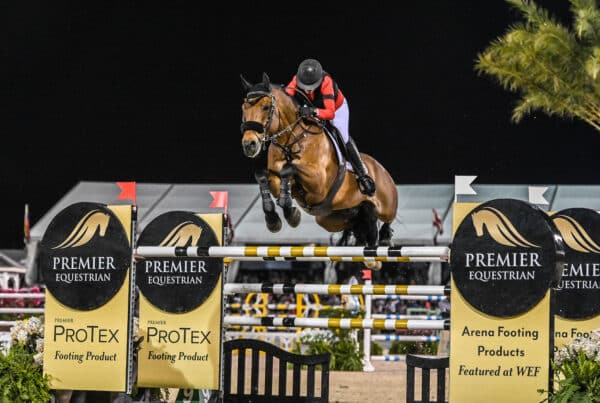The 2022 World Championship cycle kicked off last August, when the Stutteri ASK Stadium in Herning, Denmark, hosted the ECCO FEI World Championships for show jumping, dressage, para dressage, and vaulting. Some 1,200 horses representing 50 countries gathered for this year’s event, which also helped qualify nations for the 2024 Paris Olympic and Paralympic Games. Herning was chosen due to its previous experience with hosting multi-discipline championships (in 2013, they hosted the FEI European Championships for jumping, dressage and para dressage), and they annually host an FEI Dressage World Cup™ qualifier.

Premier Equestrian President Heidi Zorn proudly served as a footing advisor to the Herning organizing committee, providing expert direction on footing and riding surface conditions, both in advance of and during the competition. “Premier Equestrian was honored to be part of the footing team that helped created the best surfaces possible for the horses and athletes at Herning,” says Zorn.
After participating in this prestigious event, and as we look forward with anticipation to the FEI World Cup 2023 Finals in Omaha this April, we were inspired to dig more deeply into the history of the World Championships.
History of the World Equestrian Games
For three decades, elite equestrians from around the world have gathered every four years between Olympic Games to compete at the Federation Equestre Internationale (FEI) World Equestrian Games. Conceptualized to be a celebration of the diversity of equine sport, WEG brought together as many as eight FEI World Championship disciplines.
WEG has faced numerous challenges since its official inception in 1990, when it was fittingly held in the same stadium in Stockholm, Sweden, where the equestrian sport made its 1912 Olympic debut. First, only a handful of national federations had access to facilities large and diverse enough to meet the needs of athletes in sports ranging from endurance to eventing. This limited the number of host sites and meant that frequently, disciplines were held at venues located several hours apart, defeating the goal of bringing diverse horse sports together. In addition, though the Games drew revenue to the local economy wherever they were held, they also came with a high price tag. On several occasions, host sites began preparations only to determine that managing the Games successfully was beyond their fiscal capabilities.
After the 2018 WEG, held at the Tryon International Equestrian Center in North Carolina (a last-minute replacement venue), the FEI dismantled the “all-disciplines-under-one-umbrella” formula of WEG. Instead, countries would apply to host the World Championships only for those disciplines for which they felt qualified, effectively returning to the hosting model used pre-1990. FEI Secretary General Sabrina Ibáñez stated that this change would make hosting championships “more manageable and sustainable at proven venues”, as well as encourage applications from countries that would not have been able to host all the FEI disciplines at once. So far, the change is effective—20 countries from Europe, North and South America, and Asia all submitted expressions of interest to host a championship in 2022.
Although the World Championship format may have changed, what has remained the same is the excitement, enthusiasm, and anticipation of seeing equestrian sport’s top athletes deliver their best performances. And thanks to live streaming and FEI video releases post competition, equestrian enthusiasts from around the world can still be inspired by these performances, even if they cannot attend in person.
READ MORE ABOUT THE HISTORY OF THE SHOW JUMPING WORLD CHAMPIONSHIPS
About the author
Christina Keim is a professional equestrian and writer based at Cold Moon Farm in Rochester, NH. Over the course of her career, she has worked as a barn manager, head groom, riding instructor, and collegiate equestrian team coach. In 2015, she founded Cold Moon Farm with the mission to promote sustainable living, conservation, and the highest standards of compassionate horsemanship.





